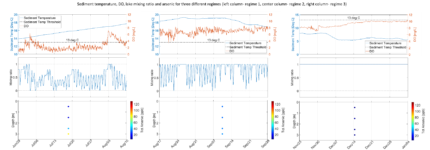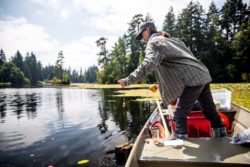BY SAMANTHA FUNG, GRADUATE STUDENT RESEARCHER, UNIVERSITY OF WASHINGTON
Lake Killarney is a small, unassuming lake in the south-central Puget Sound region. It is surrounded by trees and houses and is a popular spot for recreation- it is common to see people fishing from the shore or kayaks, or swimming during the warm summer months. Despite the lake’s picturesque quality, it is highly arsenic-contaminated, with sediment and surface water concentrations of up to 206 ppm and 70 ppb respectively. The source of the contamination was the ASARCO copper smelter in Ruston, WA, which operated from 1890 to 1986. Plumes of byproduct released in the smelter’s smokestack settled out and contaminated much of the region’s soil and lakes with arsenic.
Although the severity of arsenic contamination in lakes is generally quantified using sediment concentration, recent results from our study showed that oxic water concentration is a more accurate predictor of bioaccumulation than sediment concentration is (Barrett et al. 2018). These results highlight the importance of understanding the mixing mechanisms of lakes and the ability to predict when arsenic will be mixed up into oxic waters inhabited by lake organisms.
In the past year, we have expanded our study of Lake Killarney to look at physical as well as biogeochemical processes. From our year-long time series of water temperature, sediment temperature, DO, and arsenic data, we have found that there are distinct seasonal combinations of physical and biogeochemical characteristics that lead to differences in mobilization and distribution of arsenic.

Fig 2. Six-week plots of sediment temperature, DO, lake mixing ration, and arsenic. The three seasonal regimes, identified are shown–regime 1 (left), regime 2 (center) regime 3 (right).
Arsenic sequestered in the sediments is released by a microbially-mediated reaction that is both redox-and temperature-dependent. From field data, we have identified 13°C as the threshold temperature required for arsenic release; at temperatures below this, microbe activity is not high enough to induce noticeable arsenic mobilization. The oxygen content of bottom waters also plays a role in the magnitude of arsenic mixed from pore water up into the bulk lake water. In oxidized conditions, iron exists as solid minerals, which arsenic sorbs onto. These minerals settle to the lakebed and lower bulk water arsenic. When lake waters are anoxic, iron exists in its dissolved form and arsenic is released from the minerals, raising bulk water arsenic. Although sediment temperature and redox condition control whether arsenic has the potential to be released into the water, the lake mixing regime determines how that arsenic is distributed.
With a maximum depth of 4.5 m, Lake Killarney has been labeled as a polymictic lake that is generally fully mixed. However, by calculating the lake “mixing ratio” (mixed depth/full depth) from water temperature profiles, we have identified three mixing patterns with different time-scales of full water column mixing.
During the late spring and early summer, the lake mixes fully every few weeks. This mixing pattern, when combined with warm sediment temperatures and low DO, leads to ‘arsenic regime 1’ which is characterized by high release of arsenic from sediments that gets trapped in the bottom waters during the long periods of stratification. As shown in Fig. 2 (above), arsenic regime 1 results in a gradient of arsenic, with high concentrations near the sediment and low concentrations in surface waters.
In the late summer, the lake mixes fully every night; during this period, sediment temperature is still above the threshold and DO remains fairly high. Arsenic regime 2 is characterized by uniformly distributed arsenic throughout the water column with intermediate concentrations.
Between early fall and late spring, the sediment temperature is too low to support high levels of microbe activity, leading to low arsenic measured throughout the water column.
Identifying periods when surface water arsenic is high is important for lake management, as high toxic water arsenic leads to bioaccumulation of arsenic in low trophic level organisms and an elevated risk for swimmers and other lake users.
1. Barrett, P. M. et al. Increased exposure of plankton to arsenic in contaminated weakly-stratified lakes. Sci. Total Environ. 625, 1606–1614 (2018).









